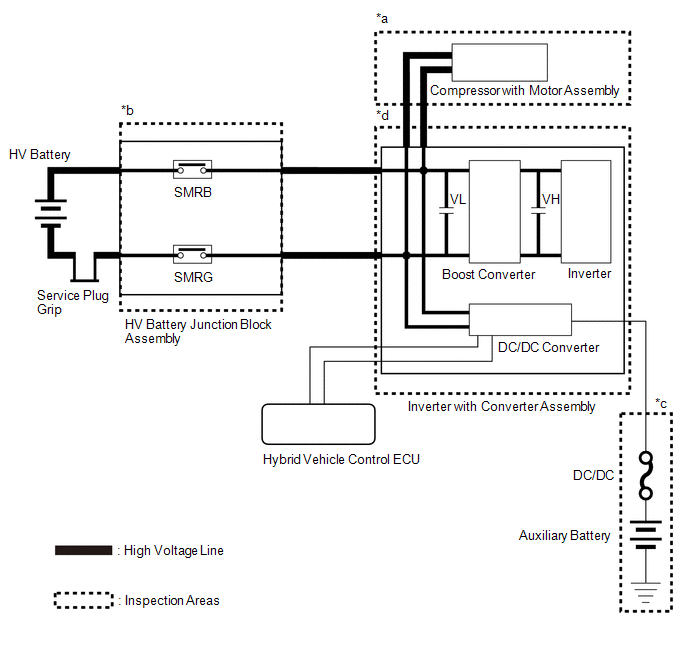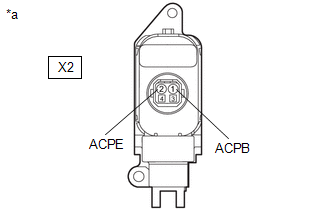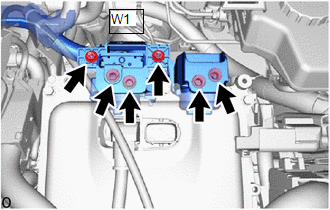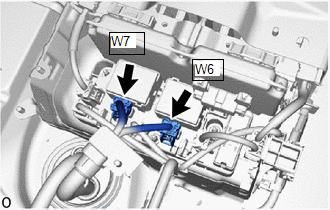Toyota Corolla Cross: High Voltage Power Resource Circuit Voltage Sensor after Boosting Malfunction (P1C8349)
DTC SUMMARY
MALFUNCTION DESCRIPTION
The hybrid vehicle control ECU monitors the high-voltage wiring between the HV battery and inverter with converter assembly and detects a power supply malfunction.
The cause of this malfunction may be one of the following:
Inverter voltage sensor (VL) internal circuit malfunction- Voltage sensor (VL) malfunction
- Motor generator control ECU (MG ECU) malfunction
- Communication (wire harness) malfunction
- HV battery malfunction
- HV battery junction block assembly malfunction
- Inverter with converter assembly malfunction
- Air conditioner system malfunction
- High-voltage wire harness malfunction
- High-voltage connector or connection malfunction
- Hybrid vehicle control ECU malfunction
- HV battery junction block assembly malfunction
- Low voltage wire harness malfunction
- Low voltage connector malfunction
INSPECTION DESCRIPTION

|
System Diagram Range |
Inspection Content | Reason |
|---|---|---|
|
*a | Check high-voltage wiring connection condition of the air conditioner compressor with motor assembly |
Check for short circuit |
|
*b | Check the high voltage cables between the HV battery junction block assembly |
Check for open circuit and defective connection (arc marks) due to looseness |
|
*c | Check connection condition and wire harness continuity between DC/DC converter and auxiliary Battery |
Check for open circuit and defective connection (arc marks) due to looseness |
|
*d | Check connection condition and wire harness continuity between DC/DC converter and hybrid vehicle control ECU |
Check for open circuit and defective connection (arc marks) due to looseness |
DESCRIPTION
Refer to the description for DTC P0AD911.
Click here
.gif)
|
DTC No. | Detection Item |
DTC Detection Condition |
Trouble Area | MIL |
Warning Indicate | Note |
|---|---|---|---|---|---|---|
|
P1C8349 | High Voltage Power Resource Circuit Voltage Sensor after Boosting Malfunction |
Although an SMR on request was sent when the ignition switch is operated, the voltage did not increase after boosting. High-voltage circuit malfunctions between the HV battery and inverter with converter assembly, or high-voltage cable has an open circuit. (2 trip detection logic) |
| Does not come on |
Master Warning: Comes on |
SAE Code: P3004 |
CONFIRMATION DRIVING PATTERN
HINT:
After repair has been completed, clear the DTC and then check that the vehicle has returned to normal by performing the following All Readiness check procedure.
Click here .gif)
- Connect the GTS to the DLC3.
- Turn the ignition switch to ON and turn the GTS on.
- Clear the DTCs (even if no DTCs are stored, perform the clear DTC procedure).
- Turn the ignition switch off and wait for 30 seconds or more.
- Turn the ignition switch to ON (READY) and wait for 30 seconds or more.
- Turn the ignition switch off and wait for 30 seconds or more.
- Turn the ignition switch to ON and turn the GTS on.
- Enter the following menus: Powertrain / Hybrid Control / Utility / All Readiness.
- Check the DTC judgment result.
HINT:
- If the judgment result shows NORMAL, the system is normal.
- If the judgment result shows ABNORMAL, the system has a malfunction.
- If the judgment result shows INCOMPLETE, perform driving pattern again.
WIRING DIAGRAM
Refer to the wiring diagram for DTC P0AA649.
Click here .gif)
Refer to the wiring diagram for DTC P19E100.
Click here .gif)
Refer to the wiring diagram for the HV Battery High-voltage Line Circuit.
Click here .gif)
CAUTION / NOTICE / HINT
CAUTION:
Refer to the precautions before inspecting high voltage circuit.
Click here .gif)
NOTICE:
- After the ignition switch is turned off, there may be a waiting time before disconnecting the negative (-) auxiliary battery terminal.
Click here
.gif)
- When disconnecting and reconnecting the auxiliary battery
HINT:
When disconnecting and reconnecting the auxiliary battery, there is an automatic learning function that completes learning when the respective system is used.
Click here
.gif)
HINT:
- P1C8349 may be output as a result of the malfunction indicated by the DTCs in table below.
- The chart above is listed in inspection order of priority.
- Check DTCs that are output at the same time by following the listed order. (The main cause of the malfunction can be determined without performing unnecessary inspections.)
|
Malfunction Content | System |
Relevant DTC | |
|---|---|---|---|
|
Microcomputer malfunction |
Hybrid control system |
P0A1B49 | Drive Motor "A" Control Module Internal Electronic Failure |
|
P060647 | Hybrid/EV Powertrain Control Module Processor Watchdog / Safety MCU Failure | ||
|
P060687 | Hybrid/EV Powertrain Control Module Processor to Monitoring Processor Missing Message | ||
|
P060A47 | Hybrid/EV Powertrain Control Module Monitoring Processor Watchdog / Safety MCU Failure | ||
|
P060A87 | Hybrid/EV Powertrain Control Module Processor from Monitoring Processor Missing Message | ||
|
P1C9E9F | Hybrid/EV System Reset Stuck Off | ||
|
P060B49 | Hybrid/EV Powertrain Control Module A/D Processing Internal Electronic Failure | ||
|
Motor generator control system | P0A1B1F |
Generator Control Module Circuit Intermittent | |
|
P0A1A47 | Generator Control Module Watchdog / Safety μC Failure | ||
|
P0A1A49 | Generator Control Module Internal Electronic Failure | ||
|
P1C2A1C | Generator A/D Converter Circuit Circuit Voltage Out of Range | ||
|
P1C2A49 | Generator A/D Converter Circuit Internal Electronic Failure | ||
|
P313383 | Communication Error from Generator to Drive Motor "A" Value of Signal Protection Calculation Incorrect | ||
|
P313386 | Communication Error from Generator to Drive Motor "A" Signal Invalid | ||
|
Hybrid battery system | P060B49 |
Hybrid/EV Battery Energy Control Module A/D Processing Internal Electronic Failure | |
|
P060687 | Hybrid/EV Battery Energy Control Module Processor to Monitoring Processor Missing Message | ||
|
P060A47 | Hybrid/EV Battery Energy Control Module Monitoring Processor Watchdog / Safety MCU Failure | ||
|
P060A87 | Hybrid/EV Battery Energy Control Module Processor from Monitoring Processor Missing Message | ||
|
P0E2D00 | Hybrid/EV Battery Energy Control Module Hybrid/EV Battery Monitor Performance | ||
|
Power source circuit malfunction | Motor generator control system |
P06D61C | Generator Control Module Offset Power Circuit Voltage Out of Range |
|
Communication system malfunction |
Hybrid control system | U011187 |
Lost Communication with Hybrid/EV Battery Energy Control Module "A" Missing Message |
|
U01BD87 | Lost Communication with DC/DC Converter Control Module "C" | ||
|
Motor generator control system |
P313387 | Communication Error from Generator to Drive Motor "A" Missing Message | |
|
Sensor and actuator circuit malfunction |
Hybrid control system |
P0AD915 | Hybrid/EV Battery Positive Contactor Circuit Short to Auxiliary Battery or Open |
|
P0AD911 | Hybrid/EV Battery Positive Contactor Circuit Short to Ground | ||
|
P0ADD15 | Hybrid/EV Battery Negative Contactor Circuit Short to Auxiliary Battery or Open | ||
|
P0ADD11 | Hybrid/EV Battery Negative Contactor Circuit Short to Ground | ||
|
P0B231C | Hybrid/EV Battery "A" Voltage Sensor Voltage Out of Range | ||
|
P0ABF00 | Hybrid/EV Battery Current Sensor "A" Circuit Range/Performance | ||
|
P0D2D1C | Drive Motor "A" Inverter Voltage Sensor Voltage Out of Range | ||
|
Hybrid battery system | P0ABF11 |
Hybrid/EV Battery Current Sensor "A" Circuit Short to Ground | |
|
P0B0E11 | Hybrid/EV Battery Current Sensor "B" Circuit Short to Ground | ||
|
P0B0E15 | Hybrid/EV Battery Current Sensor "B" Circuit Short to Auxiliary Battery or Open | ||
|
P0ABF15 | Hybrid/EV Battery Current Sensor "A" Circuit Short to Auxiliary Battery or Open | ||
|
P301A1C | Hybrid Battery Stack 1 Cell Voltage Detection Voltage Out of Range | ||
|
P1A001C | Hybrid Battery Stack 2 Cell Voltage Detection Voltage Out of Range | ||
|
P1AFD1C | Flying Capacitor/Internal Control Module Hybrid/EV Battery Monitor Voltage Out of Range | ||
|
P0ABF28 | Hybrid/EV Battery Current Sensor "A" Signal Bias Level Out of Range / Zero Adjustment Failure | ||
|
P0ABF2A | Hybrid/EV Battery Current Sensor "A" Signal Stuck In Range | ||
|
P1CBB12 | Hybrid/EV Battery Current Sensor Power Supply Circuit Short to Auxiliary Battery | ||
|
P1CBB14 | Hybrid/EV Battery Current Sensor Power Supply Circuit Short to Ground or Open | ||
|
P0B1362 | Hybrid/EV Battery Current Sensor "A"/"B" Signal Compare Failure | ||
|
Motor generator control system |
P0D2D16 | Drive Motor "A" Inverter Voltage Sensor(VH) Circuit Voltage Below Threshold | |
|
P0D2D17 | Drive Motor "A" Inverter Voltage Sensor(VH) Circuit Voltage Above Threshold | ||
|
System malfunction | Hybrid control system |
P0C7600 | Hybrid/EV Battery System Discharge Time Too Long |
|
P0D2D1C | Drive Motor "A" Inverter Voltage Sensor Voltage Out of Range | ||
|
P0A1F94 | Hybrid/EV Battery Energy Control Module Unexpected Operation | ||
|
P1C8349 | High Voltage Power Resource Circuit Voltage Sensor after Boosting Malfunction | ||
|
P1CCC49 | DC/DC Converter Internal Electronic Failure | ||
|
Motor generator control system | P0D2D16 |
Drive Motor "A" Inverter Voltage Sensor(VH) Circuit Voltage Below Threshold | |
|
P0D2D17 | Drive Motor "A" Inverter Voltage Sensor(VH) Circuit Voltage Above Threshold | ||
|
P1CB69E | Drive Motor "A" Inverter Voltage Sensor(VH) Stuck On | ||
|
P0CA300 | DC/DC Converter Step Up Voltage Performance | ||
PROCEDURE
|
1. | CHECK FREEZE FRAME DATA (HYBRID CONTROL) |
(a) Read the Freeze Frame Data of DTC P1C8349.
Powertrain > Hybrid Control > Trouble Codes|
Result | Proceed to |
|---|---|
|
All of the following conditions are met:
| A |
|
All of the following conditions are met:
| |
| Freeze Frame Data item "DC/DC Converter Unavailable Status" is ON. | |
|
Except above | B |
(b) Turn the ignition switch off.
| A | .gif) | REPLACE INVERTER WITH CONVERTER ASSEMBLY |
|
|
2. | CHECK COMPRESSOR WITH MOTOR ASSEMBLY |
CAUTION:
Be sure to wear insulated gloves.
(a) Check that the service plug grip is not installed.
NOTICE:
After removing the service plug grip, do not turn the ignition switch to ON (READY), unless instructed by the repair manual because this may cause a malfunction.
| (b) Disconnect the HV air conditioning wire from the inverter with converter assembly. HINT: Make sure that no foreign matter has entered or contaminated the HV air conditioning wire. |
|
| (c) Measure the resistance according to the value(s) in the table below. Standard Resistance:
NOTICE:
|
|
(d) Reconnect the HV air conditioning wire.
| NG | .gif) | GO TO STEP 14 |
|
|
3. | CHECK INVERTER WITH CONVERTER ASSEMBLY (HV FLOOR UNDER WIRE CONNECTION CONDITION) |
CAUTION:
Be sure to wear insulated gloves.
(a) Check that the service plug grip is not installed.
NOTICE:
After removing the service plug grip, do not turn the ignition switch to ON (READY), unless instructed by the repair manual because this may cause a malfunction.
| (b) Check that the bolts for the HV floor under wire are tightened to the specified torque, the HV floor under wire is connected securely, and there are no contact problems. Specified Condition: T = 8.0 N*m (82 kgf*cm, 71 in.*lbf) |
|
(c) Disconnect the HV floor under wire from the inverter with converter assembly.
(d) Check for arc marks on the terminals for the HV floor under wire and inverter with converter assembly.
|
Result | Proceed to | |
|---|---|---|
|
The terminals are connected securely and there are no contact problems. |
There are no arc marks. |
A |
| The terminals are not connected securely and there is a contact problem. |
There are arc marks. |
B |
| The terminals are not connected securely and there is a contact problem. |
There are no arc marks. |
C |
| The terminals are connected securely and there are no contact problems. |
There are arc marks. |
B |
(e) Reconnect the HV floor under wire.
| B | .gif) | REPLACE MALFUNCTIONING PARTS |
| C | .gif) | CONNECT SECURELY |
|
|
4. | CHECK HV BATTERY JUNCTION BLOCK ASSEMBLY (HV FLOOR UNDER WIRE CONNECTION CONDITION) |
CAUTION:
Be sure to wear insulated gloves.
(a) Check that the service plug grip is not installed.
NOTICE:
After removing the service plug grip, do not turn the ignition switch to ON (READY), unless instructed by the repair manual because this may cause a malfunction.
| (b) Check that the HV floor under wire is connected securely, and there are no contact problems. |
|
(c) Disconnect the HV floor under wire connectors from the HV battery junction block assembly.
(d) Check for arc marks on the terminals of the HV floor under wire and the HV battery junction block assembly.
|
Result | Proceed to | |
|---|---|---|
|
The terminals are connected securely and there are no contact problems. |
There are no arc marks. |
A |
| The terminals are not connected securely and there is a contact problem. |
There are arc marks. |
B |
| The terminals are not connected securely and there is a contact problem. |
There are no arc marks. |
C |
| The terminals are connected securely and there are no contact problems. |
There are arc marks. |
B |
(e) Reconnect the HV floor under wire connectors.
| B | .gif) | REPLACE MALFUNCTIONING PARTS |
| C | .gif) | CONNECT SECURELY |
|
|
5. | CHECK FLOOR UNDER WIRE |
CAUTION:
Be sure to wear insulated gloves.
(a) Check that the service plug grip is not installed.
NOTICE:
After removing the service plug grip, do not turn the ignition switch to ON (READY), unless instructed by the repair manual because this may cause a malfunction.
| (b) Disconnect the HV floor under wire connectors from the HV battery junction block assembly. |
|
| (c) Disconnect the HV floor under wire from the inverter with converter assembly. |
|
(d) Measure the resistance according to the value(s) in the table below.

|
*a | HV Floor Under Wire (Inverter with Converter Assembly Side) |
*b | HV Floor Under Wire (HV Battery Junction Block Assembly Side) |
Standard Resistance:
|
Tester Connection | Condition |
Specified Condition |
|---|---|---|
|
W1-1 (CBI) - W7-1 (CBI) |
Ignition switch off |
Below 1 Ω |
|
W1-2 (CEI) - W6-1 (CEI) |
Ignition switch off |
Below 1 Ω |
NOTICE:
Be sure not to damage or deform the terminal being inspected.
(e) Reconnect the HV floor under wire to the inverter with converter assembly.
(f) Reconnect the HV floor under wire connectors to the HV battery junction block assembly.
| NG | .gif) | REPLACE FLOOR UNDER WIRE |
|
|
6. | CHECK CONNECTOR CONNECTION CONDITION (INVERTER WITH CONVERTER ASSEMBLY CONNECTOR) |
CAUTION:
Be sure to wear insulated gloves.
(a) Check that the service plug grip is not installed.
NOTICE:
After removing the service plug grip, do not turn the ignition switch to ON (READY), unless instructed by the repair manual because this may cause a malfunction.
| (b) Check the connection condition of the low voltage connectors of the inverter with converter assembly and the contact pressure of each terminal. Check the terminals for deformation, and the connector for water and foreign matter. Click here NOTICE: Before disconnecting the connector, confirm that it is properly connected by checking that the claws of the lock levers are engaged and that the connector cannot be pulled off. OK: - The connector is connected securely. - The terminals are not deformed and are connected securely. - No water or foreign matter in the connector. Result:
HINT: When connecting the connector, connect it with the lock levers raised. Rotate each lock lever downward and make sure that the connector is securely connected. When a lock lever is fully lowered, a click will be heard as its claw engages. After the click is heard, pull up on the connector to confirm that it is securely connected. |
|
| B | .gif) | CONNECT SECURELY |
| C | .gif) | REPAIR OR REPLACE HARNESS OR CONNECTOR |
|
|
7. | CHECK CONNECTOR CONNECTION CONDITION (INVERTER WITH CONVERTER ASSEMBLY CONNECTOR) |
| (a) Check the connection condition of the hybrid vehicle control ECU and the contact pressure of each terminal. Check the terminals for deformation, and the connector for water and foreign matter. Click here NOTICE: Before disconnecting the connector, confirm that it is properly connected by checking that the claws of the lock levers are engaged and that the connector cannot be pulled off. OK: - The connector is connected securely. - The terminals are not deformed and are connected securely. - No water or foreign matter in the connector. Result:
HINT: When connecting the connector, connect it with the lock levers raised. Rotate each lock lever downward and make sure that the connector is securely connected. When a lock lever is fully lowered, a click will be heard as its claw engages. After the click is heard, pull up on the connector to confirm that it is securely connected. |
|
| B | .gif) | CONNECT SECURELY |
| C | .gif) | REPAIR OR REPLACE HARNESS OR CONNECTOR |
|
|
8. | CHECK FUSE (DC/DC) |
(a) Disconnect the cable from the negative (-) auxiliary battery terminal.
(b) Remove the DC/DC fuse from the No. 1 engine room relay block and No. 1 junction block assembly.
(c) Measure the resistance according to the value(s) in the table below.
Standard Resistance:
|
Tester Connection | Condition |
Specified Condition |
|---|---|---|
|
DC/DC fuse | Always |
Below 1 Ω |
(d) Install the DC/DC fuse.
(e) Connect the cable to the negative (-) auxiliary battery terminal.
| NG | .gif) | REPLACE FUSE (DC/DC) |
|
|
9. | CHECK AMD TERMINAL VOLTAGE |
CAUTION:
Be sure to wear insulated gloves.
(a) Check that the service plug grip is not installed.
NOTICE:
After removing the service plug grip, do not turn the ignition switch to ON (READY), unless instructed by the repair manual because this may cause a malfunction.
(b) Connect the cable to the negative (-) auxiliary battery terminal.
| (c) Measure the voltage according to the value(s) in the table below. Standard Voltage:
|
|
(d) Disconnect the cable from the negative (-) auxiliary battery terminal.
| NG | .gif) | REPAIR OR REPLACE HARNESS OR CONNECTOR |
|
|
10. | CHECK AMD TERMINAL CONNECTION CONDITION |
CAUTION:
Be sure to wear insulated gloves.
(a) Check that the service plug grip is not installed.
NOTICE:
After removing the service plug grip, do not turn the ignition switch to ON (READY), unless instructed by the repair manual because this may cause a malfunction.
| (b) Check that the nuts for the AMD terminal are tightened to the specified torque, the AMD terminal is connected securely, and there are no contact problems. Result:
|
| ||||||||||||||||||
| B | .gif) | CONNECT SECURELY |
| C | .gif) | REPLACE MALFUNCTIONING PARTS |
|
|
11. | CHECK GROUND WIRE CONNECTION CONDITION (INVERTER WITH CONVERTER ASSEMBLY) |
Click here .gif)
OK:
The ground wire is securely installed.
| NG | .gif) | CONNECT SECURELY |
|
|
12. | CHECK HARNESS AND CONNECTOR (HYBRID VEHICLE CONTROL ECU - INVERTER WITH CONVERTER ASSEMBLY) |
CAUTION:
Be sure to wear insulated gloves.
(a) Check that the service plug grip is not installed.
NOTICE:
After removing the service plug grip, do not turn the ignition switch to ON (READY), unless instructed by the repair manual because this may cause a malfunction.
(b) Disconnect the inverter with converter assembly connector.
(c) Disconnect the hybrid vehicle control ECU connector.
(d) Measure the resistance according to the value(s) in the table below.
Standard Resistance (Check for Open):
|
Tester Connection | Condition |
Specified Condition |
|---|---|---|
|
A188-5 (CNH) - I249-9 (CA4H) |
Ignition switch off |
Below 1 Ω |
|
A188-4 (CNL) - I249-22 (CA4L) |
Ignition switch off |
Below 1 Ω |
Standard Resistance (Check for Short):
|
Tester Connection | Condition |
Specified Condition |
|---|---|---|
|
A188-5 (CNH) or I249-9 (CA4H) - Body ground and other terminals |
Ignition switch off |
10 kΩ or higher |
|
A188-4 (CNL) or I249-22 (CA4L) - Body ground and other terminals |
Ignition switch off |
10 kΩ or higher |
(e) Reconnect the hybrid vehicle control ECU connector.
(f) Reconnect the inverter with converter assembly connector.
| NG | .gif) | REPAIR OR REPLACE HARNESS OR CONNECTOR |
|
|
13. | INSPECT HYBRID VEHICLE CONTROL ECU |
(a) Disconnect the hybrid vehicle control ECU connector.
(b) Measure the resistance according to the value(s) in the table below.
.png)
|
*a | Component without harness connected (Hybrid Vehicle Control ECU) |
- | - |
Standard Resistance:
|
Tester Connection | Condition |
Specified Condition |
|---|---|---|
|
I249-9 (CA4H) - I249-22 (CA4L) |
Ignition switch off |
80 to 170 Ω |
(c) Reconnect the hybrid vehicle control ECU connector.
| OK | .gif) | REPLACE INVERTER WITH CONVERTER ASSEMBLY |
| NG | .gif) | REPLACE HYBRID VEHICLE CONTROL ECU |
|
14. | CHECK HV AIR CONDITIONING WIRE |
CAUTION:
Be sure to wear insulated gloves.
(a) Check that the service plug grip is not installed.
NOTICE:
After removing the service plug grip, do not turn the ignition switch to ON (READY), unless instructed by the repair manual because this may cause a malfunction.
| (b) Disconnect the HV air conditioning wire from the inverter with converter assembly. HINT: Make sure that no foreign matter has entered or contaminated the HV air conditioning wire. |
|
| (c) Disconnect the HV air conditioning wire connector from the compressor with motor assembly. HINT: Make sure that no foreign matter has entered or contaminated the HV air conditioning wire. |
|
| (d) Measure the resistance according to the value(s) in the table below. Standard Resistance:
NOTICE: Be sure to inspect with connecting the tester probes to the tips of the terminal. |
|
(e) Reconnect the HV air conditioning wire to the inverter with converter assembly.
(f) Reconnect the HV air conditioning wire connector to the compressor with motor assembly.
| OK | .gif) | REPLACE COMPRESSOR WITH MOTOR ASSEMBLY |
| NG | .gif) | REPLACE HV AIR CONDITIONING WIRE |

.gif)




.png)
.png)
.png)
.png)


